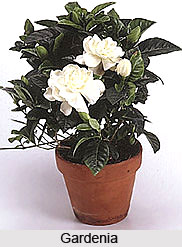 The scientists of the world named the `Gardenia` as `Gardenia Iasminoides` and this shrub is a proud member of the `Rubiaceae` family. The name `Gardenia` was given in order to show honour to the famous botanist of South Carolina, Dr. Alexandra Garden and the word `Iasminoides` means, "resembling Jasmine". It is one of the most popular shrubs in India and it has a number of names in various languages of India. Both the Hindi and Bengali speaking people named the shrub as `Gandharaj`. In Malay, this is called as `Bunga China`. It has another name in English as `Cape Jasmine`.
The scientists of the world named the `Gardenia` as `Gardenia Iasminoides` and this shrub is a proud member of the `Rubiaceae` family. The name `Gardenia` was given in order to show honour to the famous botanist of South Carolina, Dr. Alexandra Garden and the word `Iasminoides` means, "resembling Jasmine". It is one of the most popular shrubs in India and it has a number of names in various languages of India. Both the Hindi and Bengali speaking people named the shrub as `Gandharaj`. In Malay, this is called as `Bunga China`. It has another name in English as `Cape Jasmine`.
The shrub grows very well in tropical and sub-tropical conditions and also where the temperature is high. Its origin is China and Japan and it can form a dense, evergreen shrub when you keep it in shape. The shrub is always attractive as it has dark glossy foliage and some large white flowers. The flowers finish their appearance only in the Winter. The crowded leaves of the `Gardenia` grow in opposite pairs and twists. They are of a rich, pale green colour at the young age and they change to a deep, dark colour by the course of time. They are usually long and slender and they get thinner to a very short stalk. The stalk has some deep, pale-coloured nerves. The new leaves have a polished appearance because of a resinous substance contained in them.
If cultivated, the `Gardenia` usually bears double flowers that are up to 7.5 cm. across. They appear on short stalks and they are single near the ends of the twigs. They are also showy and got a very wonderful perfume. Just before the blooms fall, unluckily the pure white of the fresh flowers changes to dull ochre. The calyx of the shrub is a long, green coloured and wavy tube. This tube opens into five or six prickles or teeth. The fruit is a corrugated, orange coloured berry. It contains a pulp that is orange in colour and a lot of seeds. However, the shrub does not often bear mature fruit. Usually it propagates by cuttings or layers. There are some varieties of the shrub that have larger, double flowers.











